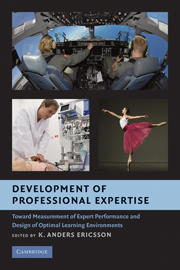 Development of Professional Expertise
Development of Professional Expertise Book contents
- Frontmatter
- Contents
- List of Figures
- List of Tables
- List of Contributors
- 1 The Measurement and Development of Professional Performance: An Introduction to the Topic and a Background to the Design and Origin of This Book
- SECTION 1 CHALLENGES IN PAST AND CONTEMPORARY EFFORTS TO MEASURE AND TRAIN THE OBJECTIVE PERFORMANCE OF PROFESSIONALS
- SECTION 2 PAST AND CONTEMPORARY EFFORTS TO DESIGN INSTRUCTION, TRAIN, AND MAINTAIN PROFESSIONAL PERFORMANCE
- 6 Research on Past and Current Training in Professional Domains: The Emerging Need for a Paradigm Shift
- 7 Designing Training for Professionals Based on Subject Matter Experts and Cognitive Task Analysis
- 8 How to Help Professionals Maintain and Improve Their Knowledge and Skills: Triangulating Best Practices in Medicine
- 9 Advances in Specifying What Is to Be Learned: Reflections on the Themes in Chapters 6–8
- SECTION 3 THE ASSESSMENT AND TRAINING OF SKILLED AND EXPERT PERFORMERS IN THE MILITARY
- SECTION 4 THE DEVELOPMENT OF EXPERTISE AND EXPERT PERFORMANCE
- Name Index
- Subject Index
- References
8 - How to Help Professionals Maintain and Improve Their Knowledge and Skills: Triangulating Best Practices in Medicine
Published online by Cambridge University Press: 04 August 2010
- Frontmatter
- Contents
- List of Figures
- List of Tables
- List of Contributors
- 1 The Measurement and Development of Professional Performance: An Introduction to the Topic and a Background to the Design and Origin of This Book
- SECTION 1 CHALLENGES IN PAST AND CONTEMPORARY EFFORTS TO MEASURE AND TRAIN THE OBJECTIVE PERFORMANCE OF PROFESSIONALS
- SECTION 2 PAST AND CONTEMPORARY EFFORTS TO DESIGN INSTRUCTION, TRAIN, AND MAINTAIN PROFESSIONAL PERFORMANCE
- 6 Research on Past and Current Training in Professional Domains: The Emerging Need for a Paradigm Shift
- 7 Designing Training for Professionals Based on Subject Matter Experts and Cognitive Task Analysis
- 8 How to Help Professionals Maintain and Improve Their Knowledge and Skills: Triangulating Best Practices in Medicine
- 9 Advances in Specifying What Is to Be Learned: Reflections on the Themes in Chapters 6–8
- SECTION 3 THE ASSESSMENT AND TRAINING OF SKILLED AND EXPERT PERFORMERS IN THE MILITARY
- SECTION 4 THE DEVELOPMENT OF EXPERTISE AND EXPERT PERFORMANCE
- Name Index
- Subject Index
- References
Summary
The greatest importance of education, formal and informal, lies not primarily in the intrinsic value of the activity to the physicians, but in how these activities benefit patients.
(Jon C. Nelson, M.D., President, AMA, 2004–2005)This chapter is about the difficulties faced by professionals to keep up-to-date with their domain knowledge and practical skills, and the frequent gap between professionals' actual practice and the best possible practice. In this chapter this gap and the associated processes are viewed primarily through the lens of the physician and his or her participation in continuing medical education (CME). This chapter considers the best evidence and clinical practice, as well as the current system of monitoring and maintaining clinical competence captured as CME credits. It proposes a model of how the best evidence can be translated and transformed into practice so that we may measure and optimize the professionals' observable performance.
To understand these issues more fully, it is necessary to understand how physicians – and indeed most professionals – keep themselves up to date. Described by Nowlen's seminal book (1988) nearly 20 years ago, the individual passes through a series of steps in education, licensure, and certification on the road to the status of a professional.
Information
- Type
- Chapter
- Information
- Development of Professional ExpertiseToward Measurement of Expert Performance and Design of Optimal Learning Environments, pp. 180 - 202Publisher: Cambridge University PressPrint publication year: 2009
References
Accessibility standard: Unknown
Why this information is here
This section outlines the accessibility features of this content - including support for screen readers, full keyboard navigation and high-contrast display options. This may not be relevant for you.Accessibility Information
- 8
- Cited by